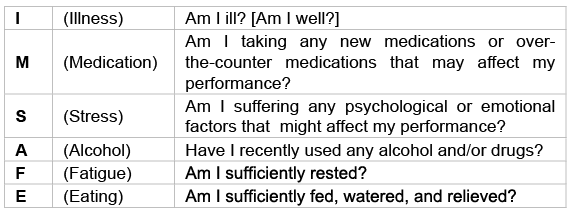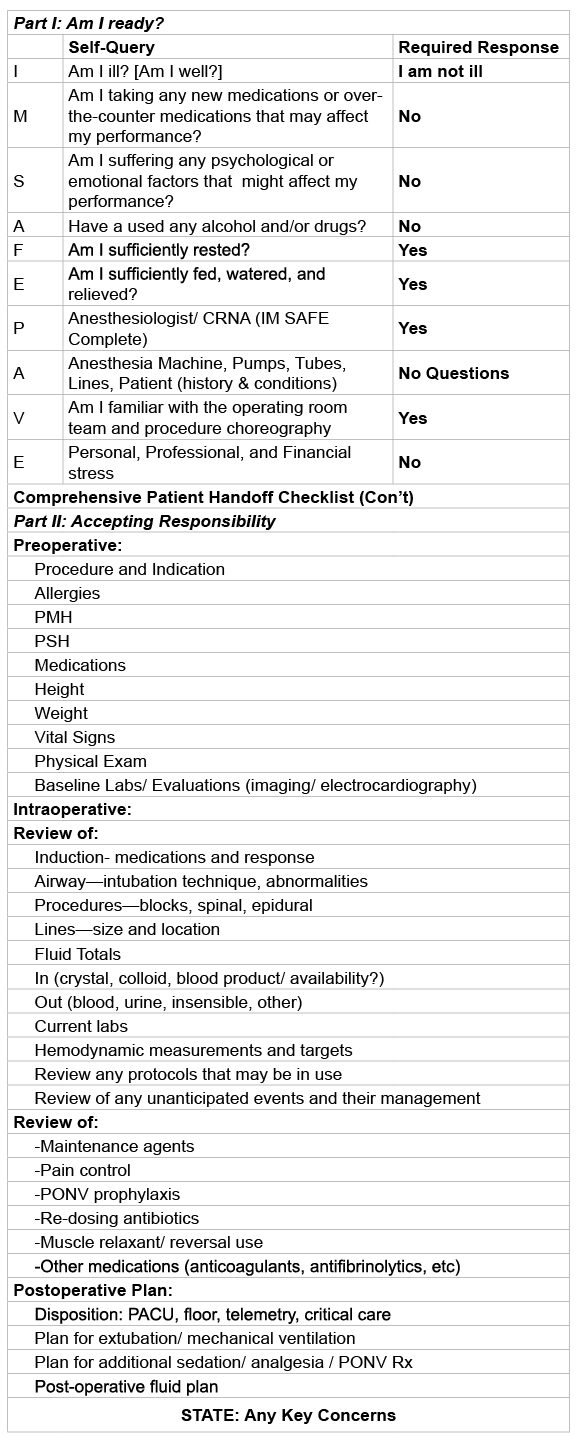
Table 1: IM SAFE to anesthetize

Joshua A Bloomstone*
Department of Anesthesiology and Perioperative Medicine, Banner Thunderbird Medical Center, Valley Anesthesiology Consultants, USA*Corresponding author:Joshua A Bloomstone, Department of Anesthesiology and Perioperative Medicine, Banner Thunderbird Medical Center, Valley Anesthesiology Consultants, Phoenix, Arizona, USA, E-mail: Jbloomstone@cox.net
Article Type: Opinion Article
Citation: Bloomstone JA (2015) Humans Fail, Checklists Don’t. J Clin Anesth Manag 1(1): doi http://dx.doi.org/10.16966/2470-9956.104
Copyright: © 2015 Bloomstone JA. This is an open-access article distributed under the terms of the Creative Commons Attribution License, which permits unrestricted use, distribution, and reproduction in any medium, provided the original author and source are credited.
Publication history:
As Dr. Jeffrey B. Cooper so aptly wrote 23 years ago, “it is essential that the dangers of relief be recognized and that suitable precautions be taken to prevent errors.” Given that the Joint Commission has identified both failures in communication and human factors as key components that lie at the root of the majority of sentinel events, effective checklist development must incorporate both if we are to truly protect perioperative patients. The greatest challenge to the success of this kind of checklist will be the clinician’s own resistance towards true and honest introspection. This commentary reviews the current state and import of communication failure and its role in patient safety as well as a methodology to reduce preventable harm when either initiating or assuming the anesthetic care of surgical patients by incorporating a comprehensive, human factors inclusive, anesthesiology specific checklist.
Checklist; Handoff; Care transition; Human factors; Anesthesiology; Sentinel events; Communication; Perioperative
tJC: The Joint Commission
“Anesthesiologists and anesthetists commonly substitute for one another. What is the effect of such relief on anesthetic risk? Is the relieving anesthesiologist more vigilant so that errors and near misses are less likely to occur and more likely to be detected? Or, by being less familiar with the patient and procedure, is the relieving anesthesiologist more likely to make a mistake?”
“When one anesthesiologist relieves another, the reliever should determine the following [Situation, Status, Future needs of the patient] before the original anesthesiologist exits.”
“Having and following a defined protocol at every relief exchange may be a good way to reduce mistakes” [1].
“More than 40 million patients undergo surgery in the United States annually and are subsequently transferred to a PACU or ICU for recovery.
These transfers are characterized by poor teamwork and communication, patients arriving in a compromised state, unclear procedures, technical errors, unstructured processes, interruptions and distractions, lack of central information repositories, and nurse inattention because of multitasking” [2].
Though causality remains unproven, poor-quality, non-standardized handovers and perioperative adverse events are associated.
Twenty-three years ago, Dr. Jeffrey Cooper became the first engineer to investigate the risks involved with patient handoffs between anesthesia providers. Furthermore, he was one of the very first individuals to consider the import and association of anesthesiologist vigilance on error occurrence and critical incidents [1]. It is disheartening that his keen insights, which have proven to be true [3], have yet to be adopted as standard practice within the perioperative space. Of interest, his recommendations, which are supported by Joint Commission (tJC) recommendations, standards, and now a national patient safety goal [4], have yet to be fully implemented within his prestigious Boston based healthcare facility and remain largely unimplemented nationwide [5].
An analysis of 3548 sentinel events occurring between 1995 and 2005 performed by the tJC demonstrated that “inadequate communication between care providers is consistently the main root cause of sentinel events”. Indeed, failures in communication represented greater than 60% of all root causes [6]. Given these results, in 2006, the tJC initiated National Patient Safety Goal #2 with the purpose of encouraging accredited institutions to create standardized hand-off procedures in an effort to enhance healthcare provider-to-provider communication. In 2008, Kitch et al. [5] demonstrated that “fifty-nine percent of residents reported that one or more patients had been harmed during their most recent clinical rotation because of problematic handoffs, and 12% reported that this harm had been major. The overall handoff quality was reported to be fair or poor by 31% of residents” [5]. In 2010, Chang et al. [7] demonstrated that “the most important piece of information about a patient was not successfully communicated” in 60% of physician-to-physician handoffs. Analysis of sentinel event root causes in 2010 demonstrated that failures in communication were still the number one cause. Taken together, these data prompted tJC to publish a Sentinel Event Alert regarding the import of communication failure [8] and now required institutions seeking tJC accreditation to implement standardized hand-off procedures. Unfortunately, the tJC’s most recent summary of sentinel event root causes [9] suggests that we have failed in our goal to improve vital communication in spite of prospective data demonstrating that implementing a formalized hand-off program reduces medical errors and preventable adverse events [10].
Local barriers to implementation likely explain our continued lack of success. These are numerous and include lack of problem recognition, negative attitudes towards practice standardization, noisy environments in which clinicians are forced to communicate, information overload, stress, multitasking, time pressures, language barriers, frequent interruptions and distractions, lack of vital communication training, poor standardization of hand-off content, and physician hubris [11-13]. As with any QI initiative, especially where standardization of care is concerned, these barriers are best addressed by identifying key stakeholders (Stakeholder Analysis) early in the project design. Furthermore, successful implementation requires the inclusion of these stakeholders in all phases of the project [14].
While Cooper postulated that poorly performed hand-offs could represent a cause for patient harm within the operating environment, proof of his speculation would take 22 years to materialize. Indeed, Saager et al. [15] have convincingly demonstrated that “intraoperative anesthesia care transitions are strongly associated with worse outcomes” and that each handoff increases the risk of any major in-hospital morbidity or mortality by 8%. The authors conclude that adherence to a patient-focused checklist could improve outcomes.
Can perioperative patient care transitions be made safer? The answer is most assuredly yes, however, absolute proof remains elusive [13]. While the American Society of Anesthesiologists (ASA) has recently published its PUTS PATIENT FIRST handover checklist [16], there are no studies demonstrating reduced errors, near misses, or better outcomes utilizing it. Furthermore, there is no formal implementation and audit strategy offered to institutions wishing to utilize it. Finally, given that the ASA checklist lacks focus on specific details, such as current IV access, variability in handoff reporting is likely to continue with information gaps that may prove critical to patient safety.
While the benefits of using checklists are now well established, checklists that ensure the transfer of patient information exclusively may not significantly reduce “high-risk events or realized errors” [13]. Indeed, the most recent tJC summary of sentinel event root causes also highlights the import of human factors including fatigue, illness, drug-alcoholor medication side effects, and emotional stress which are well known to affect both individual and team functioning [17]. To my knowledge, there are no currently published checklists for healthcare professionals that consider the critical import of their physical and emotional readiness for assuming patient care. Recognizing the critical role of human factors in aviation safety, there exist checklists such as IM SAFE (Table 1) and PAVE (Table 2), that unveil critical factors about the pilot and his/her environment prior to flight. These are to be completed by the pilot prior to boarding an aircraft, and are both recognized and encouraged by the FAA for their potential to save lives [18].
The PAVE and IMSAFE checklists are applicable to the work we do as anesthesiologists and should be considered prior to rendering care. Pilots who dismiss these critical self-reflective checklists as unimportant or inconsequential embody what the FAA refers to as “hazardous attitudes,” which place the pilot and passengers at risk, not to mention those beneath them. “Studies have identified five hazardous attitudes that can interfere with the ability to make sound decisions and exercise authority properly: anti-authority, impulsivity, invulnerability, macho, and resignation” [18]. Like pilots, clinicians who regard PAVE and IM SAFE as irrelevant or not applicable to their practice may also be said to suffer from these attitudes and thus place their patients at risk.

Table 1: IM SAFE to anesthetize

Table 2: PAVE the way

Table 3: Comprehensive Patient Handoff Checklist
These introspective, human factors checklists could be modified to the clinical environment and incorporated into a comprehensive patient and doctor focused handoff checklist (Table 3), and though speculative, would likely result in enhanced patient safety. There is little doubt that perioperative clinician hubris would likely result in significant resistance to the implementation of such human factors checklists. Indeed, full adoption would require a complete shift in culture, even though not one of us would contemplate boarding an aircraft with a pilot who “failed” any of the IM SAFE check items.
Our health system has successfully implemented perioperative checklists within 28 medical centers [19]. Careful deliberate stakeholder analysis, the inclusion of all subject matter experts and stakeholders into the define, design, and implementation phases is critical. Top down understanding and buy-in of the project, frequent education, communication, audit, and feedback are required for implementation success and more important for sustainability. The greatest challenge to the success of an enhanced, human factors inclusive checklist will be the clinician’s resistance towards true and honest introspection.
As Dr. Cooper so aptly wrote 23 years ago, “it is essential that the dangers of relief be recognized and that suitable precautions be taken to prevent errors” [1]. Given that the tJC has identified both failures in communication and human factors as key components lying at the root of the majority of sentinel events, effective checklist development must incorporate both if we are to truly protect perioperative patients.
The author declares that they have no competing interests
Download Provisional pdf here
All Sci Forschen Journals are Open Access